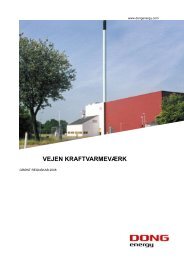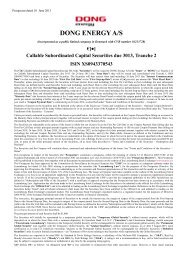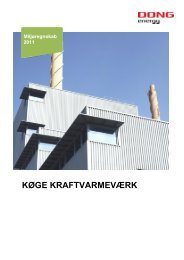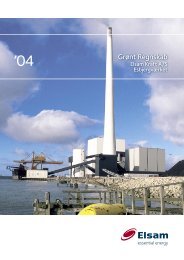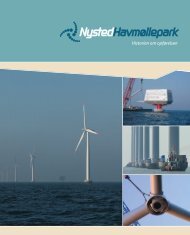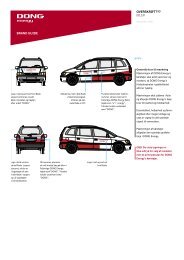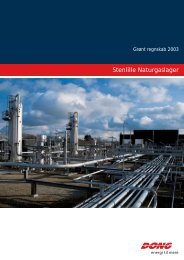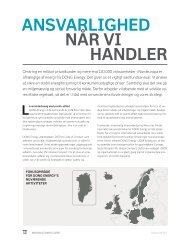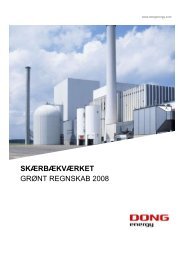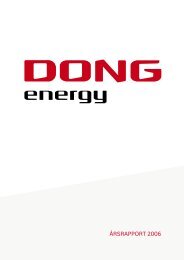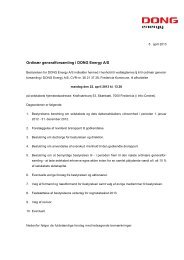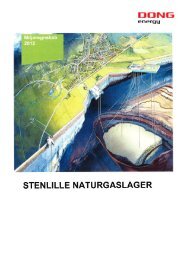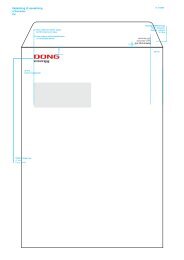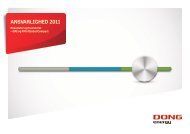ANNUAL REPORT 2011 - DONG Energy
ANNUAL REPORT 2011 - DONG Energy
ANNUAL REPORT 2011 - DONG Energy
Create successful ePaper yourself
Turn your PDF publications into a flip-book with our unique Google optimized e-Paper software.
do not satisfy the criteria for hedge accounting are recognised<br />
as revenue. Likewise, value adjustments of financial contracts<br />
offered to customers with a view to price hedging are recognised<br />
as revenue.<br />
fuel and energy<br />
Fuel and energy comprise the Group’s purchases of fuel in the<br />
form of gas, coal, biomass and oil, and energy purchases, as<br />
well as transportation costs in connection with the above and<br />
costs related to CO2 emissions. The costs are recognised in<br />
profit for the year as incurred.<br />
property, plant and equipment<br />
Property, plant and equipment comprise land and buildings,<br />
production assets, exploration assets, other assets, tools and<br />
equipment, etc. Property, plant and equipment are measured at<br />
cost less accumulated depreciation and impairment losses.<br />
Cost comprises purchase price and any costs directly attributable<br />
to the acquisition until the date the asset is available for<br />
use. The cost of self-constructed assets comprises direct and<br />
indirect costs of materials, components, subsuppliers and<br />
labour. Borrowing costs relating to both specific and general<br />
borrowing directly attributable to assets under construction<br />
with a lengthy construction period are recognised in cost during<br />
the construction period. Cost is increased by the present<br />
value of the estimated obligations for dismantling and removing<br />
the assets and restoring the site to the extent that they<br />
are recognised as a provision. In the case of assets held under<br />
finance leases, cost is determined at inception of the lease<br />
as the lower of the fair value of the assets and the present<br />
value of future minimum lease payments. The present value is<br />
determined using the interest rate implicit in the lease as the<br />
discount rate or an approximated value.<br />
Subsequent costs, for example in connection with replacement<br />
of parts of an item of property, plant and equipment, are recognised<br />
in the carrying amount of the asset in question when it<br />
is probable that future economic benefits will flow to the Group<br />
from the expenses incurred. Replaced parts are derecognised<br />
from the balance sheet, and their carrying amount is taken to<br />
profit for the year. All other repair and maintenance expenses<br />
are recognised in profit for the year as incurred.<br />
Exploration assets comprise acquired licences and reserves<br />
as well as exploration expenses that relate to successful wells.<br />
Costs are recognised using the successful efforts method.<br />
Under the successful efforts method, exploration expenses for<br />
drilling specific exploration wells are recognised in the balance<br />
sheet if the well is successful. Recognition in the balance sheet<br />
is maintained pending determination of commercial viability.<br />
Recognised exploration expenses for commercial discoveries<br />
are transferred to property, plant and equipment under construction<br />
on commencement of the construction of a field.<br />
All exploration expenses determined as unsuccessful are recognised<br />
in profit for the year as other external expenses. General<br />
exploration expenses are also recognised as other external<br />
expenses as incurred. Borrowing costs relating to exploration<br />
assets are recognised in profit for the year as incurred.<br />
Site development and construction costs relating to property,<br />
plant and equipment that it has been decided to invest in are<br />
recognised in the balance sheet within property, plant and<br />
equipment under construction until the date of entry into service.<br />
Following entry into service, these assets are transferred<br />
to the relevant items under property, plant and equipment.<br />
In the case of oil and gas production assets, cost is depreciated<br />
using the unit-of-production method based on the ratio of current<br />
production to estimated reserves by individual field.<br />
In the case of wind turbines, cost is depreciated taking into<br />
account the expected earnings profile, so that the depreciation<br />
pattern reflects the expected earnings patterns.<br />
In the case of other property, plant and equipment, cost is basically<br />
depreciated on a straight-line basis over the estimated future<br />
useful lives. Exploration assets and assets under construction<br />
are not depreciated, as depreciation of such assets does<br />
not commence until the assets are available for use, on which<br />
date they are transferred to the relevant item within property,<br />
plant and equipment, usually production assets.<br />
<strong>DONG</strong> ENERGY <strong>ANNUAL</strong> <strong>REPORT</strong> <strong>2011</strong> – COnsOliDatED finanCial statEmEnts<br />
131<br />
notes



